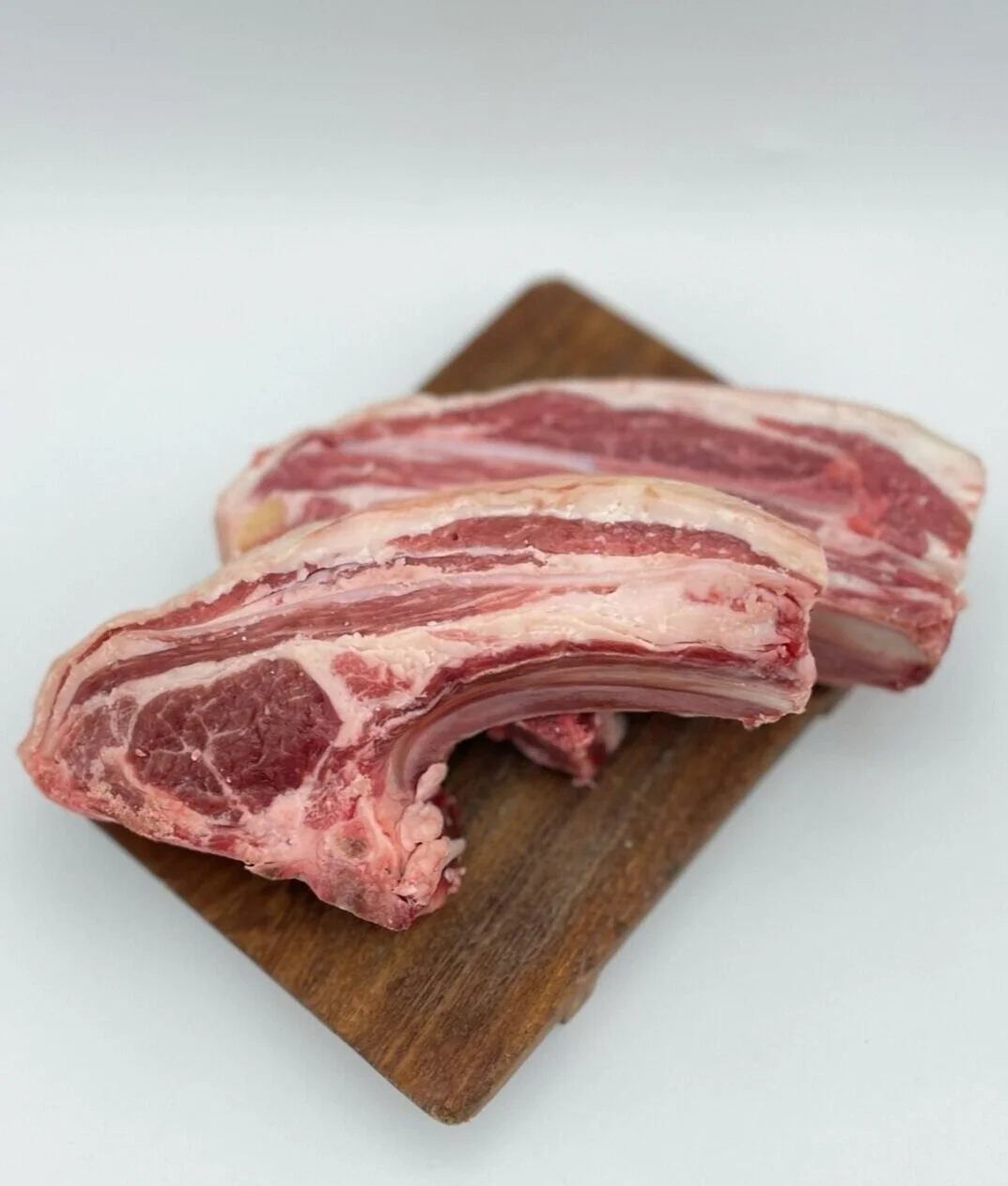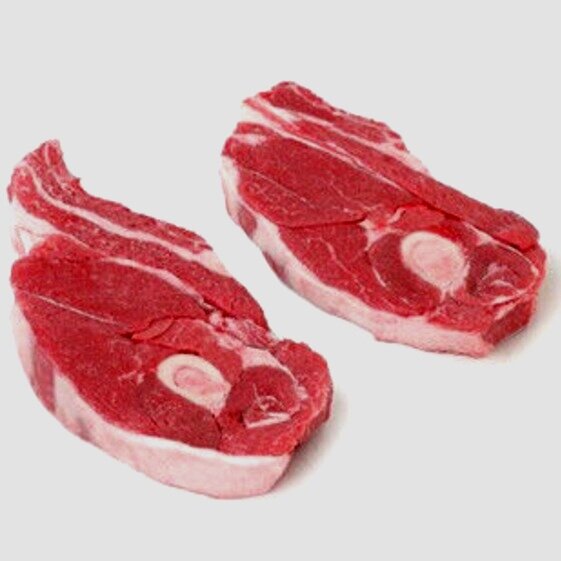Aren't All Lamb Chops the Same? REVISITED
Editor’s Note: This article has been the most popular post on our blog for almost a year. Since we just got another shipment of Emigh Lamb, I thought I’d give it a facelift and repost. Enjoy!
There’s a lot of confusion when it comes to lamb steaks, or are they chops? Step into a butcher shop or grocery store, and you might find a blade chop, leg steak, lollipop or saddle chop. Have I already got you confused?
But not every lamb steak is created equal. What most people don’t realize is that lamb steaks come from different parts of the animal with very different textures, flavors, cooking techniques, and pricing. Here’s a list of the five most common searing cuts Electric City Butcher offers every time our 100% Grass-Finished Emigh Lamb shows up. They’re in order of guest preference, although all are unique and delicious. I’ll help you navigate how to order them—and more importantly—how to cook them. I’ve thrown in a few secret butcher tips to boot.
The Rib Chop — I’ve never been asked for a lamb ribeye, but that’s what you’re getting when you order the most popular cut of lamb. Known as the “rack,” rib chop, or lollipop, rib chops are made up of a large, single loin muscle and a slender rib bone. Mild in flavor, the entire rack can be roasted whole on high heat, or seared quickly in a pan as individual chops. Expect at least two chops per guest. It’s also likely “Frenched.” No we’re not assaulting our chops. “Frenched” simply means skillfully exposing and cleaning about half of the rib bone from the chop—it looks cool. A delicious alternative is to remove the bones entirely, and roll the loin into a cylindrical noisette. If you want to be super badass—if not a little snooty—interlace two fully Frenched racks into an elegant table centerpiece, the Guard de Honour.
Cooking Tip #1: I think these chops should always be pan seared. They are too delicate to end up on the grill. Roasting is not a bad way to go either, but make sure to cover any exposed bones with some foil to prevent scorching. Serve rare, 125°F.
Butcher’s Tip #1: The rib chop is the OG Tomahawk Steak. But what most guests don’t realize is that you’re paying a lot more for basically…bone. The butcher’s not ripping you off. It takes time to properly “French” a rack, and we’re making the cut lighter, so we have to charge more. To save some money, buy your racks “trimmed” not “Frenched.” This exposes only about an inch of bone. The cut still looks elegant, but has larger portions for hungrier guests, and saves some dough. Cook these rare!
The Loin Chop — This one is a bit of a misnomer, as the rib chop mentioned above is also technically made up of loin meat. A more accurate term would be T-bone, or short loin chop—but I don’t make the rules. If you look closely, you’ll see the loin chop does look like a baby beef Porterhouse with a generous portion of strip loin and tenderloin (the most tender cut of lamb), separated by the chine bone. The loin chop actually starts as a saddle, which gets its name because it looks like…a saddle. When crosscut, the saddle makes the very rare, double chop, or saddle chop—two lamb porterhouses end to end, yum!
Cooking Tip #2: This sear-able badboy, is probably the best of the loin cuts to go on the grill. Thicker than the rib chop, it stands up to direct heat for longer, and the bone helps keep the center pink. Steaks can never be too rare, but don’t cook this chop over 130°F in the center.
Butcher’s Tip #2: The loin chop can be turned into my favorite cut of lamb, the saddle roast. The entire short loin is deboned leaving a boneless porterhouse, a cylindrical slab of tenderloin and strip loin wrapped in a generous fat cap. Seared and roasted—or rotisseried over a wood fire at my house—the roast feeds six, and can be easily sliced into incredibly tender, and flavorful medallions of the best parts of the animal. If you haven’t tried it, we’ll hook you up, but order ahead!
The Leg Chop — Butcher’s never tire of new ways to give Americans more of what they want when it comes to meat—a BBQ-friendly, searable steak that is also delicious. Leg steaks (I’ve seen them referred to as Leg Chops at Vons) are one of those inventions. The largest lamb steak, these are typically cross cut slab of meat from the upper portion of the hind leg. You should see generous portions of lean meat, (top, bottom, and eye round) with a perfectly round leg bone just off-center. Although these chops offer generous portions, and deliciously flavorful meat, they require longer cooking time.
Cooking Tip #3: A rare, seared leg chop will probably disappoint. Cooked on the grill to a good medium (130-135°F) and finished with a drizzle of olive oil, a dollop of yogurt, and sprinkled with za’atar, this is one of my favorite ways to serve the largest of lamb steaks.
Butcher’s Tip #3: For the best cut of leg steak, ask for a sirloin chop. This is commonly lumped in with the leg steak, but actually isn’t part of the leg at all. Surprise, surprise, it’s from the…sirloin, which is just in front of the pelvis (or aitch bone for us meat heads). The sirloin is often separated from the carcass along with the leg. Any good butcher can make two or three chops once they remove the aitch bone. The sirloin chop is probably the most tender and flavorful cut on the animal—after the rib and loin chops that is.
The Shoulder Chop — Also known as a blade chop, this is a cut I often see in the grocery store, and one that disappoints many would-be lamb lovers. One of the most economical of chops, this crosscut steak can be very flavorful. Unfortunately, what you gain in flavor, you loose in texture. There is a lot of chew on this steak due to the intense bands of connective tissue common to the hard-working shoulder muscles. The thick ribbons of fat also don’t render completely when searing. Most people don’t realize that lamb’s “gamy” flavor (you either love it or hate it) originates in the fat. If some of that fat doesn’t cook out, the grassy, lamby flavor is intensified! I prefer to leave this cut in the crockpot, or roasted whole on the bone, or better yet, made into carnitas for a family favorite, lamb tacos!
Cooking Tip #4: Don’t undercook these guys. Rare is for the loin. The shoulder chop is ideal for a reverse sear or sous vide to allow the thicker pieces of fat to render, and the chewy bits to break down. To get some color, finish each chop with a quick sear in a scorching pan until 135-140°F
Butcher’s Tip #4: There are one or two good searing steaks off the back of the shoulder (closest to the rack, and furthest from the arm). If you need two steaks in a pinch, ask your friendly Electric City Butcher to cut from the loin end of the shoulder. Not the prettiest chops, but they’ll get the job done.
The Arm Chop — Lamb are of the four-legged variety, but in Butcher Land, our animals have arms. On larger lamb, like in the spring after healthy winter rains, the front legs—I mean arms—have good steak-worthy meat on them before the muscles turn into the more slender and tougher lamb shank (strictly braising meat). These foreleg chops tend to be smaller in size and structure than the more common leg steaks. In my opinion, these steaks are leaner and chewier than shoulder chops, and less flavorful.
Cooking Tips #5: If this is your only option, or you’re trying to save a few bucks, make sure to cook these guys like a shoulder chop. Low and slow, then sear. One benefit is you’ll get a bit of marrow from the arm bones. After cooked, spoon out the marrow and spread it on a piece of crusting bread for a fun appetizer.
Butcher’s Tip #5: The lamb arm quickly becomes more bone than meat as things move towards the shank. Because this is a working muscle, the meat can also be very tough. The bone should be no more than 1” in diameter, circular in shape, and offset to one side of the chop. Larger diameter, irregular shape, or bone in the middle of the steak means it’s from too far down the leg, and should be saved for stew.







